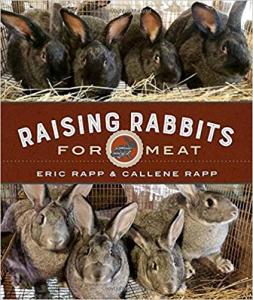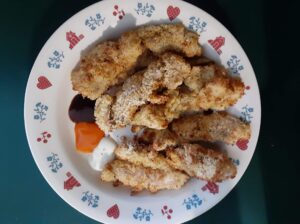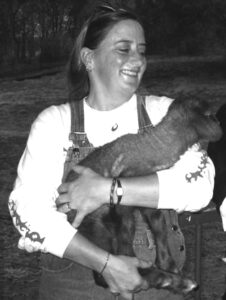By Eric and Callene Rapp, Rare Hare Barn
Eric and Callene Rapp, members of The Livestock Conservancy, focus on the conservation of heritage breed rabbits at Rare Hare Barn. They are the authors of Raising Rabbits for Meat, a how-to guide to help you succeed in starting and running a home rabbitry for a steady source of meat or income.
Have you ever wondered about raising meat rabbits, but weren’t sure if it was a good idea or not?
Rabbits are one of the most sustainable meat species to raise. They have a lower environmental footprint, and with a little good and consistent care, will reward you with high quality meat for your family.

Our focus at Rare Hare Barn has been conservation of heritage breeds. The breeds we chose to focus on are dual-purpose breeds, selected for both meat and fur quality, and the animals are larger than many of the breeds in vogue more recently.
Changes in the food system after World War II favored more intensive, large-scale meat production with animals such as cattle and pigs, and rabbits fell out of favor. With the rise of industrial agriculture and the advent of subsidized meat production…rabbit declined in popularity and availability as a homestead meat animal.1
Fortunately, people are rediscovering how useful rabbits are on the homestead. Rabbits can be raised in a variety of environments, can adapt to nearly any management scheme, and can provide a plethora of useful products. Small and quiet, they require much less in the way of fencing and space, but give back well beyond what they require from us.2
Rabbit meat has some of the highest nutritional content of any type of meat. Very low in fat and cholesterol, it is high in protein and many essential vitamins and minerals. Rabbits are also a very fine boned animal, meaning there is a greater meat-to-bone ratio than may be found in other meat animals.
A rabbit can also produce multiple litters in a year, meaning a steady supply of meat for the table. Their short gestation period (30-32 days), weaning at 5-6 weeks, and ability to rebreed soon after weaning means a good doe, kept in good condition and with good nutrition, can produce 3-4 litters a year. And if the doe weans 6-8 kits, that’s potentially 32 fryers per year!
Rabbits are also exceptionally easy to process. Unlike chickens, which must be plucked, a rabbit can be skinned in a matter of minutes, with no extra equipment to de-feather or time spent pulling feathers. The hide can also be tanned for home use or sold as an extra byproduct.
Rabbit meal is lean. The key to remember [for cooking rabbit]: low and slow. This lack of fat can present a challenge for cooks who are not familiar with cooking lean meat. It can take a little practice to get comfortable cooking with rabbit, but the benefits are worth it.3
Speaking of by-products: don’t forget about rabbit manure! That stuff is pure gold for the garden. If you don’t happen to garden, I bet there is someone close by who would pay you to take the stuff off your hands!
Here are a few ways we love to cook rabbit!
- One of the best ways to fry rabbit is in Harold Ensley’s Catfish Seasoning, which should
 be available in most grocery stores.
be available in most grocery stores.
Also, rabbit can be coated with a seasoning rub and baked in the oven. Just be sure to pull the front legs out of the oven first, as there is less meat and they will get overdone! We call those appetizers in our house!
- Rotisserie on the grill, slathered in Zesty Italian dressing and melted butter. Also we use one of those injection things to insert the butter/dressing into the meat. This is Eric’s favorite way to cook rabbit. On the gril for about an hour, basting with the butter/dressing mixture regularly, the meat is super tender and delicious, and many times we just eat it straight from the grill.4
- Rabbit Pot Pie! Any good chicken pot pie recipe will work. This one uses frozen vegetables, cream of chicken soup and canned biscuits for the crust!
You can find more recipes in Raising Rabbits for Meat.

***
 Eric and Callene Rapp run the Rare Hare Barn. They currently raise the American Chincilla (Eric’s favorite) and the American Blue and White (Callene’s favorite). They have both served two terms on The Livestock Conservancy board of directors. Heritage breeds are important and need to be preserved. We both believe livestock should get to be livestock. We are big fans of low-stress handling and believe that by handling them in a calm manner helps both farmer and livestock. Animals should be able to thrive without a lot of input and everything we raise works perfectly for our farm.
Eric and Callene Rapp run the Rare Hare Barn. They currently raise the American Chincilla (Eric’s favorite) and the American Blue and White (Callene’s favorite). They have both served two terms on The Livestock Conservancy board of directors. Heritage breeds are important and need to be preserved. We both believe livestock should get to be livestock. We are big fans of low-stress handling and believe that by handling them in a calm manner helps both farmer and livestock. Animals should be able to thrive without a lot of input and everything we raise works perfectly for our farm.
- Rapp, E., & Rapp, C. (2018). Raising Rabbits for Meat (pp. 8-9). New Society Publishers.
- Rapp, E., & Rapp, C. (2018). Raising Rabbits for Meat (pp. 4). New Society Publishers.
- Rapp, E., & Rapp, C. (2018). Raising Rabbits for Meat (pp. 142). New Society Publishers.
- Rapp, E., & Rapp, C. (2018). Raising Rabbits for Meat (pp. 143). New Society Publishers.



